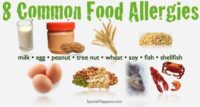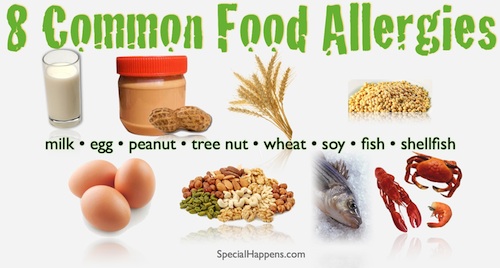









Food allergies affect many Americans. Food allergies occur when the body’s immune system reacts to certain proteins in a food. Even a tiny amount of the allergy-causing food can cause symptoms, such as digestive problems, hives, lip swelling or swollen airways, wheezing, nasal congestion or trouble breathing, abdominal pain, diarrhea, nausea or vomiting, dizziness, lightheadedness or fainting. In some people a food allergy can cause severe symptoms or a life-threatening reaction called anaphylaxis which may involve fatal respiratory problems and shock. Symptoms may occur within a few minutes – to a couple hours after eating. *
If one has a severe reaction called anaphylaxis – with symptoms including constriction and tightening of the airways, a swollen throat or the sensation of a lump in the throat making it difficult to breathe, shock with a drop in blood pressure, rapid pulse, dizziness, lightheadedness or loss of consciousness – emergency treatment is critical.*

Foods that have been identified, by U.S. Congress, as major allergens are:**
Cow’s milk
Crustacean shellfish such as shrimp, lobster, and crab
Peanuts,
Tree nuts such as walnuts and pecans,
Fish,
Eggs,
Wheat,
Soy
Sesame (will be added January 1, 2023)
Consumers should realize that the major allergens are defined for the purpose of labeling. For example, “milk” is interpreted as milk from the domesticated cow. However the proteins in cow’s milk are very similar to those found in milk from goats, sheep, deer and buffalo. For the purpose of labeling FDA interprets “eggs” as eggs from chickens; however, the proteins in chicken eggs are very similar to those in eggs from ducks, geese, quail and other birds. Thus before consuming milk or eggs from other animals consult your health care provider.**
There is no cure for food allergy at this time. Some children do outgrow their allergy as they get older. Thus early recognition and avoiding foods that cause signs and symptoms is essential.
The Food and Drug Administration provides guidance to food processors and consumers on how to best manage allergen hazards in food. The FDA requires companies to list ingredients on packaged foods and beverages.
There are several other food ingredients that may cause allergic hypersensitivity reaction in sensitive persons that require specific labeling, such as Gluten, food colors, carmine, sulfites, etc., which the FDA is also monitoring.
Gluten is a protein found in some grains (wheat, barley, and rye). In persons with celiac disease, foods that contain gluten triggers an immune response that attacks and damages the lining of the small intestine. This can limit the persons ability to absorb nutrients but may also cause problems leading to cancers and autoimmune diseases such as diabetes.** .
Color additives can cause sensitivity to some persons and must be identified on the label. FD&C Yellow is an example found in beverages, desserts, processed vegetables, drugs, makeup, etc., and may cause itching and hives. Color additives made from cochineal extract and carmine and sulfating agents including sodium bisulfite must also be listed on the label .**
If one knows they have a food allergy – follow these steps:*
Read food labels carefully
Wear a medical alert bracelet or necklace to let others know, in case you have a reaction and are unable to communicate.
Talk with your doctor
Be careful at restaurants – letting your server or chef know that that you cannot eat certain foods
Plan meals and snacks before leaving home and take allergen-free foods with you when you travel or go to an event.
If your child has a food allergy, notify key people that your child has a food allergy – school personnel, parents of your child’s friends and other adults who interact with your child. Explain that a reaction could be life-threatening and requires immediate action. Make certain that your child knows to ask for help right away.
Write a Plan of action describing what has to be done if the child has an allergic reaction.
Have your child wear a medical alert bracelet or necklace.
Therefore if you have a food allergy – know what you are eating and drinking. Read food labels for purchased food and if in a restaurant or at a party – ask – explain to your server or hostess that you cannot eat a certain food.




- https://www.mayoclinic.org/diseases-conditions/food-allergy.symptoms-caises/syc-20355095?p=1
** https://www.fda.gov/food/food-labeling-nutrition/food-allergies






